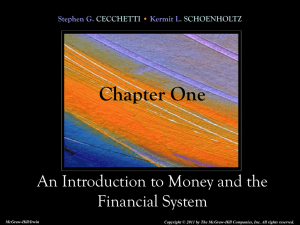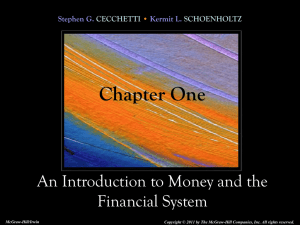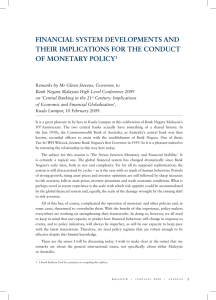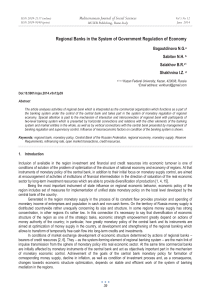Chapter 1 An Introduction to Money and the
advertisement
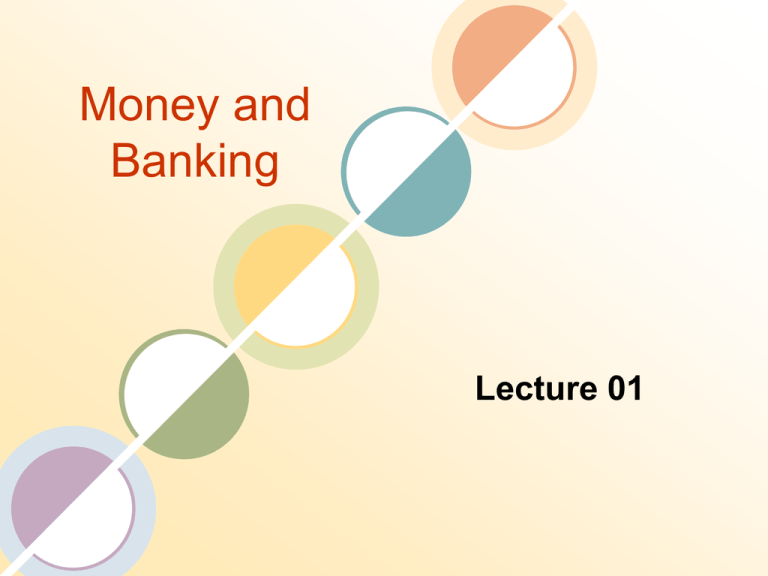
Money and Banking Lecture 01 Text and Reference Material • The Primary textbook for the course will be • “Money, Banking and Financial Markets” by Stephan G. Cecchetti International Edition, McGraw Hill Publishers, ISBN 0-07-111565-X” 1-2 Text and Reference Material • Reference books will be • “The Economics of Money, Banking and Financial Markets”, by Fredrick S. Mishkin 7th Edition Addison Wesley Longman Publishers • “Principles of Money, Banking and Financial Markets” by Lawrence S. Ritter, Willaim L. Silber and Gregory F. Udell, Addison Wesley Longman Publishers 1-3 Course Contents • Money and the Financial System • Money and the Payments System • Financial Instruments, Financial Markets, and Financial Institutions • Interest rate, Financial instruments and financial markets • • • • • Future Value, Present Value and Interest Rates Understanding Risk Bonds, Pricing and Determination of Interest Rates The Risk and Term Structure of Interest Rates Stocks, Stock Markets and Market Efficiency 1-4 Course Contents • Financial Institutions • • • • Economics of Financial Intermediation Depositary Institutions: Banks and bank Management Financial Industry Structure Regulating the financial system • Central Banks, Monetary Policy and Financial stability • • • • Structure of central banks Balance sheet and Money Supply process Monetary policy Exchange rate policy 1-5 Course Contents • Modern Monetary Economics • • • • Money growth and Money Demand Aggregate demand Business Cycle Output and inflation in the short run • Money and Banking in Islam • Monetary and financial policy and structure for an Interest-free economy • Islamic Banking in the contemporary world 1-6 Five Parts of the Financial System 1. 2. 3. 4. 5. Money Financial Instruments Financial Markets Financial Institutions Central Banks 1-7 Five Parts of the Financial System 1. Money • • • • • To pay for purchases To store wealth Evolved from gold and silver coins to paper money to today’s electronic funds transfers Traditional Paycheck system vs. ATM Withdrawals Mailed transactions vs. E-banking 1-8 Five Parts of the Financial System 2. Financial Instruments • To transfer wealth from savers to borrowers • To transfer risk to those best equipped to bear it. • once investing was an activity reserved for the wealthy • Costly individual stock transactions through stockbrokers • Information collection was not so easy • Now, small investors have the opportunity to purchase shares in “mutual funds.” 1-9 Five Parts of the Financial System 3. Financial Markets • To buy and sell financial instruments quickly and cheaply • evolved from coffeehouses to trading places (Stock exchanges) to electronic networks. • Transactions are much more cheaper now • Markets offer a broader array of financial instruments than were available even 50 years ago 1-10 Five Parts of the Financial System 4. Financial Institutions. • Provide access to financial markets • Banks evolved from Vaults and developed into deposits- and loans-agency • Today’s banks are more like financial supermarkets offering a huge assortment of financial products and services for sale. • • • • • Access to financial markets Insurance Home- and car-loans Consumer credit Investment advice 1-11 Five Parts of the Financial System 5. Central Banks • • • • • Monitors financial Institutions stabilizes the Economy Initiated by Monarchs to finance the wars The govt. treasuries have evolved into the modern central bank control the availability of money and credit in such a way as to ensure 1. low inflation, 2. high growth, and 3. the stability of the financial system. • State Bank of Pakistan www.sbp.org.pk 1-12 Summary • Five Parts of the Financial System • • • • • Money Financial Instruments Financial Markets Financial Institutions Central Banks 1-13 Upcoming Topics • Five Core Principles of Money and Banking • • • • • Time has Value Risk Requires Compensation Information is the basis for decisions Markets set prices and allocate resources Stability improves welfare • Financial System Promotes Economic Efficiency • Facilitate Payments • Channel Funds From Savers to Borrowers • Enable Risk Sharing 1-14 Upcoming Topics • Money • Characteristics of Money • Liquidity • Payment system • Commodity vs. Fiat Money • Cheques • Other forms of payments • Future of Money • Measuring Money 1-15



